Page content
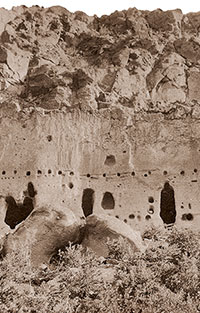
National Archives
The Puye Ruins in New Mexico, declared a National Historic Landmark in 1966, the year the National Historic Preservation Act was passed.
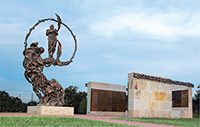
Sharon Miller
The Contrabands and Freedmen’s Cemetery Memorial in Alexandria, Virginia, where some 1,700 former slaves are buried.
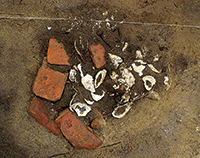
James River Archaeological Society
Oyster shells found near a cabin door in Suffolk County, Virginia, point to the survival of African traditions in the New World.
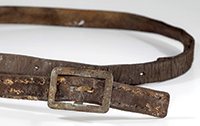
Presidio Trust
After the Presidio military base in San Francisco closed, archaeologists uncovered evidence of early settlers from Mexico.
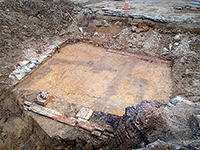
Missouri Department of Transportation
French colonial history in the St. Louis area, such as this foundation, was recovered because of the Preservation Act.
Uncovered History
The National Historic Preservation Act
by Gil Klein
On a grassy rise just outside historic Old Town Alexandria in Virginia, a memorial sits atop a cemetery where some of the 20,000 slaves who had fled to Union lines were buried during and just after the Civil War
The sacredness of the memorial is in stark contrast to the roar on the other side of a sound barrier, as tens of thousands of vehicles barrel every day across the newly reconstructed Woodrow Wilson Bridge, the main interstate link between the Northeast and the Southeast.
A common bond connects the memorial park and the $2.5 billion bridge reconstruction project: the National Historic Preservation Act, which is approaching its fiftieth year. The act has been called “the people’s law,” because it has promoted archaeological and historical research about the common man and forgotten peoples across the United States. And nowhere is that more obvious than in this memorial park.
Because of the act, the Virginia Department of Transportation called in archaeologists to survey the property where historical records indicated a cemetery existed. What the archaeologists found was row after row of African American burials—more than 630. That discovery was tied to a historic document known as the Book of Lists, which included the names of roughly 1,700 freedmen buried at the site between 1864 and 1869, as well as pieces of information about them.
A citizen activist movement sprang up to convince the federal and city governments to buy and tear down an adjacent office building and gas station that had been constructed on top of part of the cemetery. The city hired a genealogist, who found descendants of long-forgotten people buried here. Where the gas station once stood is now a monument that lists all 1,711 names, etched in bronze, and commemorates the struggle of the thousands of slaves who fled to freedom in Union-occupied Alexandria during the war. The Contrabands and Freedmen’s Cemetery Memorial opened in September 2014.
“Archaeology was used here to right an injustice,” said Francine Bromberg, Alexandria’s acting archaeologist. “The story of what went on at this site is really a story about survival not only of the graves but also of the family members of those buried here and their descendants.”
This string of events took place because of Section 106 of the National Historic Preservation Act. Since its enactment in 1966, the act has led to the exploration of hundreds of thousands of possible historic and archaeological sites, thousands of digs, work on historic buildings, and preservation of millions of artifacts. Section 106 of the law requires that every project that involves federal money, permits, or licenses must be surveyed to determine whether historic properties or archaeological sites will be affected.
If they are, project managers must try to minimize the impact. The upshot is that archaeological investigations and historic building assessments are done before construction begins.
Since 1966, many states have initiated their own preservation laws that cover projects on state lands not addressed by the federal act. And many municipalities have enacted ordinances that cover local construction projects. “Without the laws, development would have rolled over much of our cultural patrimony and made it inaccessible,” said Stanley Bond, chief archaeologist for the National Park Service, who keeps track of the work done under the act. It has been used to explore sites more than 13,000 years old of the earliest people in North America and to sift through the wreckage of the World Trade Center after the 9/11 terrorist attacks.
“Sometimes people ask, What have your found for all the money we have spent?” said Jeff Altschul, president of the Society for American Archaeology. “Much of what we have found is of rich cultural heritage and historic value to groups that are otherwise ignored or disenfranchised.” Yet for all that has been found because of the law, he said, much is still being lost. “In my hometown of Tucson, we estimate that 80 percent of the archaeological sites have been destroyed by development,” he said. “Yes, we are doing a fair amount of archaeology in Tucson, but it is only a small percentage of what was there. That’s true of any fast-growing metropolitan area.”
Before the National Historic Preservation Act, archaeology was conducted mostly by college professors who took students to excavate sites that piqued their interest. But after the act, vast new territories had to be explored. An array of private archaeological firms has sprung up to search for clues from the past in places no one would have thought to look. It has become a vibrant industry employing a large majority of the approximately 12,000 archaeologists working in the United States today. How much is spent annually is hard to estimate, because the numbers are hidden in the budgets for federal, state, and local construction projects.
The law is credited with uncovering historical evidence of groups that had been overlooked or marginalized, and with filling in huge tracts of the historical record. “Section 106 is the people’s law,” Bond said. “We have this idea that history is written by rich white men or the victors. But archaeology gives us a way to get the other side of the story to people who haven’t had much written about them—or things that were written about them were written by outsiders. Ultimately, archaeology tells everyone’s story.”
Developers and construction project managers often balk at the cost and delays of the archaeological work, Bond said, “but the law has been around since 1966, and in many ways people have adjusted to it. Even if they don’t recognize the significance of it, they recognize that they have to do it.”
Four examples from across the United States give an idea of what the act can accomplish.
Suffolk, Virginia
Repair of a dam in Suffolk, Virginia, gave Garrett Fesler and the James River Institute of Archaeology a chance in 2010–11 to explore an untouched site of slave cabins that could be dated to a period from 1828 to 1838. The site, downriver from the 1607 settlement at Jamestown, had not been disturbed since it was abandoned, said Fesler, who cut his archaeological teeth at Colonial Williamsburg while studying at the College of William and Mary. “The artifacts in the ground were in their original locations,” he said. “When they dropped out of the hands of someone nearly 200 years ago, they were in the same location. It’s like Pompeii. These things were frozen in the ground for us to recover.”
In their painstaking hand excavation of the site, they recovered 8,000 artifacts documenting the life of slaves from that time. What interested Fesler most was a pit near where the door of one of the cabins had been. Inside the pit was a bed of oyster shells with an iron hoe blade resting on top. In some West African cultures, he said, iron was considered a sacred substance, and the pit indicated it was put by the door to protect the household, much as a Christian family would put a cross in a house as a mark of their belief. “One of the big issues for many African Americans today is to be able to link their heritage to African roots,” Fesler said. “Here we found conclusive evidence that West and Central African spiritual practices were taking place a generation after the slave trade ended.”
That counters claims in many histories that slaves baptized by white planters accepted Christianity, he said. The people living in these cabins had a deep understanding of their African past. “These people were able to persevere and maintain a sense of themselves and where they came from,” he said.
New Mexico
Lynne Sebastian is the immediate past president of the Register of Professional Archaeologists, a former president of the Society for American Archaeology, and currently a presidential appointee to the Advisory Council on Historic Preservation. She is working on a project called “Making Archaeology Public,” which is encouraging volunteer coordinators to produce fifty videos, one for each state, celebrating some of the major discoveries in the fifty years since Section 106 was enacted.
For her home state, Sebastian is highlighting not one project but rather the entire mosaic of New Mexico prehistory that has been uncovered because of the act. Before the act, she said, archaeology in New Mexico was largely limited to professors and their students studying either 12,000-year-old paleo-Indian sites, such as those of the Clovis people, or the huge Pueblo sites dating from about 1,500 years ago. But in between were thousands of years of prehistoric human development. “It was kind of like those old maps that said, ‘Here, there be dragons,’ for the parts of the world where they didn’t know what was there,” she said. “We had thousands of years of prehistory that we really had no idea as to what it was like.”
Now, as a result of Section 106, nearly 300,000 archaeological sites are on the map of New Mexico, great numbers of them dating to those missing years. Using advanced geographic information systems, researchers can begin to see the patterns of life over those thousands of years. “It is kind of like a Monet painting,” she said. “It’s all of these little dots of information. You can’t see anything when you are up close, but when you step back and look at the whole picture, amazing patterns emerge.”
San Francisco, California
Section 106 has allowed archaeologists to explore the mostly forgotten life of the early settlers arriving in the San Francisco Bay Area in the 1770s from Spanish-held Mexico, which controlled California as a province. “We have this Zorro concept of the history of California,” the National Park Service’s Stanley Bond said, referring to the 1950s TV show that portrayed early Californians as Spanish grandees. “But in reality, all of the original settlers who came to California from Mexico were of mixed-race descent.”
In an attempt to counter Russians who were moving south into North America, the Spanish in Mexico sought to create a settlement in the Bay Area, he said. The Spanish captain who led the expedition went to one of the poorest places in Mexico, recruited men to become soldiers and to bring their families—300 people in all—who traveled 1,600 miles, mainly by foot and leading a large herd of livestock. In that original expedition, he said, a third of the people had some African ancestry, and practically all had American Indian ancestors.
They founded the Presidio on San Francisco Bay, which remained in military hands until 1989, when it was given to the National Park Service. Redevelopment of the Presidio triggered Section 106, requiring an investigation that has uncovered evidence of those early settlers. Archaeologists found more than a quarter-million artifacts dating to the late eighteenth century. Perhaps the most significant discovery was the stone foundation of an adobe house believed to belong to Juana Briones, who lived there from 1815 to 1830. Briones was a founding member of the pueblo of Yerba Buena—a settlement that became San Francisco—and ran a prosperous farming business.
“In a generation or two,” the settlers “were doing quite well,” Bond said. “It’s the American story. But it was a completely unknown story.”
St. Louis, Missouri
Halfway across the continent in St. Louis, Missouri, a project to reconstruct the ramps to a Mississippi River bridge offered archaeologists a rare opportunity to explore the city’s early history. The archaeological team thought they would uncover tremendous amounts of nineteenth-century debris, but what they found was startling.
It had been assumed that all remnants of the French colonial period had been destroyed as the city was built and rebuilt over the centuries, said Michael Meyer, chief archaeologist for the Missouri Department of Transportation. But “everywhere we looked there was evidence of the French colonial period dating from around 1770. It wasn’t just an isolated spot. It was everywhere.” The evidence showed that those people were not living hand-to-mouth. There was a degree of affluence that the fur trade was bringing to the nascent city.
Meyer said the discovery caused a bit of a sensation in St. Louis, which for years had largely ignored archaeological work exploring the nineteenth century. But the archaeologists have to work fast. Such projects delay construction—and that costs money. “We are about halfway done, but the bulldozers are here,” Meyer said in early May 2014. “We have enough time to finish the work, but conditions will be difficult. We take what we can get.”
Even after nearly fifty years, archaeologists say the National Historic Preservation Act is working well. Lynne Sebastian said she once convened a seminar of archaeologists to determine how the law needed to be changed. She asked them to think as broadly as they could and to suggest any way the law and regulations could be altered so that the archaeology could be improved. “What was fascinating was that we found there is nothing wrong with the law or the regulations,” she said. “The problem is in the implementation. There is so much flexibility built into the regulatory process, and people don’t take advantage of it. They get really hidebound about process. All of the things we came up with to improve it are things that could happen tomorrow.”
For Bond, the problem is not in the archaeology but in how the information that is uncovered is made accessible to the public. “We need to show people how we use objects to learn about cultures of the past,” he said. “No one cares that you surveyed so many acres and found so many sites. They want to know what we learned about the lives of the people who lived on those sites.”
Back in Alexandria, Virginia, Garrett Fesler is now working for the city’s archaeology department, administering the local ordinance that protects the city’s storied past. From his office in an old torpedo factory that has been converted into an artist center, he is only steps from the historic district, which dates to the mid eighteenth century. Much of what he does is compare the historic record with proposed construction sites to see whether anything could be found before the work begins. The code is the reason the city has such a complete historic record, he said, which helps bring in tourists and boost property values.
Just recently, he checked on a site where construction workers had uncovered some early nineteenth-century artifacts. The site had been a tavern and bathhouse going back to the late eighteenth century, and the artifacts had been in a pit dug in the tavern’s basement, most likely in the early 1820s. “It turned out that the owner of this property is very excited to have this,” Fesler said. “He is going to preserve the pit in place and interpret it, then cover it in Lucite and light it and put the artifacts on display.”
Virginia journalist Gil Klein, former national correspondent for Media General News Service in Washington, is past president of the National Press Club and an American University assistant professor. He contributed a story on United States currency to the winter 2014 journal.
Suggestions for further reading:
- Section 106 Success Stories: American Council on Historic Preservation: http://achp.gov/sec106_successes.html?
- Federal Archaeology Report: nps.gov/archeology/SRC/INDEX.HTM
